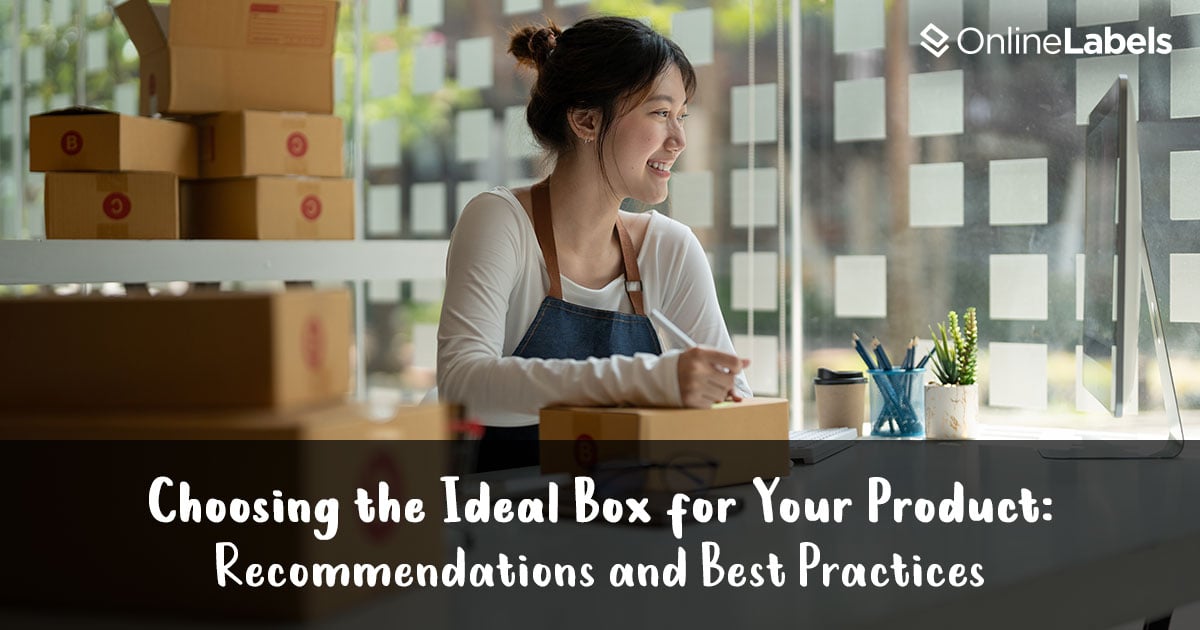Choosing the Ideal Box for Your Product: Recommendations and Best Practices

Having bomb product packaging goes beyond just labels. Product labels set the stage for what’s inside, but if the product is sold in a box, that box needs to be just as or even more eye-catching. Going beyond visual appeal, high-quality product boxes are just the right size — not too big and not too small. Plus, it’s probably a good idea to know exactly what size your boxes will be before you even start designing.
In this article, we’ll dive deeper into different product box styles, how to get the correct measurements, and more.
Consider the product
Before doing anything else, consider some attributes of the product that’ll be placed inside the box. Its size, shape, and weight should aid in determining the size and strength of the box that’s required. You will also need to consider the type of packaging material that is suitable for the product, such as cardstock or corrugated cardboard, and the type of cushioning that may be required to protect the product during shipping.
Choose a product box type
Mailer Boxes
Mailer boxes are small to medium-sized boxes made of corrugated cardboard that typically have built-in cushioning. These boxes don’t require extra materials like tape to seal the box, but instead are auto-locking, and feature a hinged top that folds in and seals shut.
Mailer boxes are ideal for packaging multiple lightweight products in one box to be shipped, to create a fun unboxing experience for the recipient.
Folding cartons
These are used for products that are sold on shelves, or individual products shipped in a shipping box. They’re typically made of cardstock (in a range of thicknesses), or the heavier duty corrugated cardboard. So make sure you choose wisely, as heavy products will need a thicker material.
Folding cartons are versatile and can be used for most products, including candles, cosmetics, food items, stationary, and so much more.
Keep in mind that cardstock boxes will need additional packaging when being shipped — either a shipping box or a mailer box. But, if your folding carton is made of corrugated cardboard, you can ship it as is. When in doubt, test it out the old fashioned way by shipping the product and seeing if it gets to its destination safely.
It’s important to do research and know what the box standards are for what you sell. In most cases, you don’t need to necessarily fit the mold, but it can at least get you started in the right direction. Plus, these standards exist for a reason — it’s likely that specific box styles and sizes are the most practical for certain products.
Different styles of folding cartons include:
- Straight Tuck End Boxes: most popular and suitable for a variety of products
- Reverse Tuck End Boxes: similar to straight tuck end boxes but the flaps tuck in opposite directions
- Snap-Lock Bottom Boxes: ideal for slightly heavier products
- Auto-Lock Bottom Boxes: ideal for heavier products
- Five Panel Hanging Boxes: used for retail hanging displays
- Seal-End Boxes: glue is required to seal the ends, and it is typically used in the food and health industries
- Pillow Boxes: these bend into shape and are ideal for small, lightweight items
- Dispenser Boxes: feature a window that’s able to dispense individually-wrapped products
We recommend consulting with your box retailer about which option is best for what you’re selling.
As we continue discussing packaging in this article, we’ll mostly be dealing with folding cartons.
Determine the box size
To choose the right size box, you first need to measure the dimensions of the product you’re boxing.
All you need to do is measure the length, width, and height of the product with a straight ruler. Once you have those measurements, add fractions of an inch or centimeter if you want some wiggle room. You only want your box to be as big as you need it to be.
Does your product require cushioning such as bubble wrap or kraft paper? Don’t forget to account for the extra room these require when determining the final measurements.
Note: keep in mind that any box manufacturer will ask for the inside dimensions of the box you're looking for, not the outside. This is because for thicker materials, the inside and outside dimensions will be slightly different.
Enhance the packaging
Now that you know what box type and size you want, let’s make it stylish (and more practical)! There are a few ways to enhance your box:
- Cardstock inserts: These are custom cut cardstock spacers that are placed snugly inside the box to hold the product in place, and make for a more fun unboxing experience
- Window cut-out: It’s exactly what it sounds like — a window cut into your box! It can be anywhere on the box (even on the corner) and allows the customer to get a sneak peak of how the product looks, feels, or smells
- Window patch: Exactly like the window cut-out, except the patch features a clear plastic film over the window, so customers can catch a glimpse of the product. This is a popular option for cosmetics
- Perforations: Add lines of tiny holes that allow customers to easily tear off a portion of the box. Perforations are typically used for dispenser boxes
After some research and trial and error, you’ll find the perfect combination of style, size, and enhancements for your product boxes!
Need product labels? Shop our premium label solutions for high-end labels to enhance shelf appeal, or fill out the form below.


